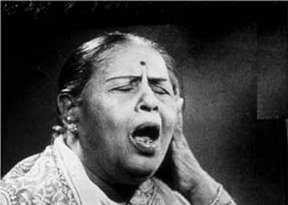Mataji, Vidushi Siddheswari Devi

Born on 8’th August 1908, in Banaras, Siddheshwari Devi had her initial training in Indian Classical music from Pandit Siyaji Maharaj. Later, she also trained under Pandit Bade Ram Dasji of Banaras. Siddheshwari shifted from Banaras to Delhi in 1965 and taught music in Shriram Bharatiya Kala Kendra for more than a decade till she passed away in 1977.
Siddheshwari Devi’s music represented Banaras Gharana style, which lays more emphasis on the intensity of feelings and expression of emotions through musical notes and voice modulations. A stalwart of thumri, Siddheshwari’s music also included khayals, dhrupads, dadras, tappas, kajris, chaitis, horis and bhajans. In thumris she specialized in “Poorabang” thumri, which is also known as the “Bol-Banav-ki thumri”. Reliance on ragas was a distinctive feature of Siddheshwaris thumris. She helped in raising thumri to a classical form. She earned the title of “Thumri-Queen” and was presented the much coveted Padma Shree award in 1967.
Siddheshwari Devi strongly believed in “Guru Shishya Parampara” which has been kept alive by her daughter Vidushi Savita Devi. Savita established “Smt Siddheshwari Devi Academy of Indian Music” in the loving memory of her mother in 1977, the year in which Siddheshwari passed away.
Mataji, Vidushi Siddheswari Devi taught vocal technique and repertoire at the Kathak Kendra during the latter years of her life. In retrospect it seems inconceivable that an artist of such magnitude would teach a beginner such as I was, when I arrived at the Kathak Kendra in summer 1967. Yet she was fascinated by the musical sophistication I had acquired during thirteen years of professional training in western flute and piano, combined with my perfect vocal pitch and utterly unmodulated voice in terms of Indian vocal technique. I was a blank slate. I naively accepted the gifts Mataji gave me, whether a thumri in rag Jog or food which she cooked, while I cut onions in her kitchen on Sundays. Senior students and artists including Rita Chatterji graciously accepted my inclusion in Mataji’s circle of art and love.
Mataji’s full-throated, ungirlish range and daring flights up and down the raga shook me physically and shaped my aesthetic during those joyous moments when I sat with her – in the classroom, in her Pataudi House living room, and on stage in Lucknow and New Delhi. Since concerts at which she sang often lasted from early evening until early morning, I often heard other great artists such as Ustad Bismillah Khan.. For me Mataji embodied generosity, vulnerability, devotion, complex simplicity and artistry. She is joined by her daughter Savita in the on-stage photo of her typical singing position – her left hand covering one ear and the right hand extended toward the audience. When she gave me her tiny portrait – the second image of this unpretentious and open-hearted genius, she asked me to guess what was in her mind when it was snapped. Finally she said quietly —- OM.



